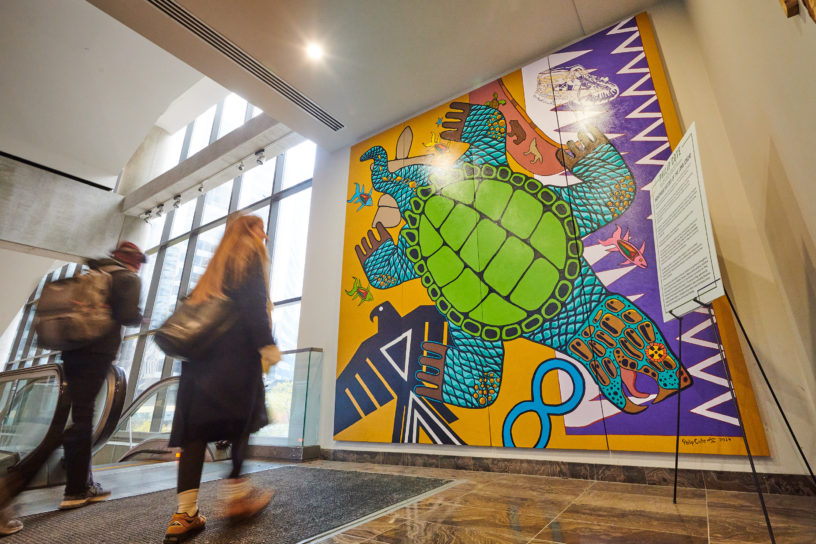By Jake MacAndrew
A mural titled “Indigenous History of the Land” was unveiled at the Ted Rogers School of Management (TRSM) this month as a part of Toronto Metropolitan University’s (TMU) Indigenous Education and Treaties Recognition Week.
The painting by Shawnee, Lakota, Potawatomi, Ojibway and Algonquin artist Philip Cote uses cultural symbols to represent various historical events and Indigenous peoples.
The TRSM website states that the mural’s goal is to recognize the school is “within the Toronto Purchase Treaty No.13 with the Mississaugas of the Credit First Nation and that we are located on the traditional lands of the Ojibway, the Mississaugas of the Credit First Nation, the Haudenosaunee, and the Huron-Wendat peoples.”
The mural is on display at the landing before the seventh floor of the TRSM building.
The art piece is also Cote’s second mural on campus. His first, entitled “Morning Star at the Eastern Doorway,” was commissioned by the Faculty of Community Services and unveiled in early 2023. At its reveal, Cote said the mural represented the beginning of humanity in North America.
In an artist talk at TRSM on Nov. 5, Cote discussed the historic and cultural significance of each of the symbols included in the painting, explaining that each one represents a group of Indigenous peoples.
Painted across the centre of the mural is a giant turtle representing Turtle Island, the Algonquian term for North America.
In some Ojibway oral traditions, Sky Woman fell through a hole in the heavens and landed on a giant turtle’s back during a great flood. Some of the other animals who survived the flood tried to swim to the bottom of the water to collect a small amount of soil so new life could grow.
Cote said many animals tried to bring soil to the surface but failed. The last creature, a muskrat, was able to bring a pawful of soil onto the turtle’s back before dying from exhaustion. This sacrifice allowed life to grow anew and meant Turtle Island became the centre of creation.
“It’s a symbolic connection that connects to the land and connects you,” Cote said as he retold the story. “If you start paying attention to them, you really realize that they’re not just stories.”
In the lower-left corner of the painting is a black Thunderbird—a symbol that represents the three fires of the Ojibway, Ogawa and Potawatomi peoples—though Cote said it could represent over 40 nations who use the symbol.
Within the Thunderbird are four triangles of wisdom that Cote said his ancestors spoke of often. The first three triangles represent identity and a sense of both belonging and responsibility. Once a person has achieved those elements, they are able to feel the fourth triangle—the peace that comes with Indigenous peoples reconnecting with their true identity.
“Not with the one that’s being made up by the settlers,” Cote explained, “but the one that’s made up by our ancestors.”
Other symbols on the mural had more direct connections to the communities they were associated with. For example, both the Inukshuk—for the Inuit—and the infinity symbol—for the Metis—are reminiscent of the icons on the Nunavut and Metis flag respectively. The canoe is used to represent the Wendat peoples and the Wampum belt running along the mural’s right side is a symbol of the Haudenosaunee Confederacy.
For Cote, the mural is about educating others on Indigenous history while using Indigenous peoples as the primary source of information.
“Our oral history is a lot more accurate than the colonial archives because it’s a living history,” Cote said. “If I’m telling you a story about ancient times, you are now part of this ancient history because it’s going to go from my lips to your ears, to your lips to someone else’s ear.”
Cote did extensive research while preparing to create the large-scale work of art. He visited the Bata Shoe Museum to study different types of moccasins and spoke to other Indigenous leaders to ensure his representations were accurate.
Some community members brought up concerns about the mural location’s accessibility being between two staircases without elevator access.
Sana Mulji, senior advisor of equity, diversity, inclusion and accessibility at the TRSM, said the issue came up during the planning process but the school is using the learning experience as a stepping stone towards more accessible artwork in the future.
“We recognize it’s not an accessible space, so we had the conversation with [Cote] that, if this is a space that we are choosing, we can make it accessible through digital sharing,” she said.
Mulji said the planning for the mural took years and was ultimately driven by a panel of Indigenous entrepreneurs that the university hosted.
“We asked them, ‘What gave you a sense of belonging when you were in an academic institution?’ Unanimously, every single one of them said art,” Mulji recounted.
To Cote, the mural symbolizes more than a sense of belonging on campus—it is a tool to empower other Indigenous individuals.
“I went through a lot of racism growing up in this city and I experienced it from every nation. When I was a boy, I couldn’t defend myself because I didn’t know any of my own history,” Cote said in his artist talk.
“That’s why this is important. To know your own history is to give you a leg to stand on.”











Leave a Reply